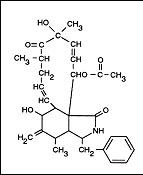Cytochalasin D
Properties: Solubility in water is low, stock solutions of DMSO (20 mM) stored at -20°C can be used. Working concentrations are in the range of 5-20 µM (coleoptiles, Wang and Nick 1998; thale cress roots, Baskin and Bivens 1995)
Molecular Target: 1 Cytochalasin molecule binds to the actin filament. Binding occurs at the barbed end causing a block of both association and dissociation. Dissociation at the opposite end continues, resulting in a gradual decay of the microfilament (Cooper 1987). The Kd of binding is around 2 nM for Cytochalasin D. Interaction with CD causes filament shortening (severing activity) - additional binding in the filament center? CD can bind actin monomers as well causing dimerization, it raises the critical concentration for actin polymerisation.
Specificity: Cytochalasin D is around 10 times more effective than Cytochalasin B. Cytochalasin B also blocks monosaccharide transport across the membrane. For cytochalasin D, so far, no side effects are known.
Cellular Effects: Cytochalasin increases the exclusion size of plasmodesmata and blocks cytoplasmic streaming (Ding et al. 1996). Depolymerisation of microtubules increases the cellular sensitivity to cytochalasins (Collings et al. 1996). CD blocks the effect of BFA on the cycling of PIN-proteins (Geldner et al. 2001)

